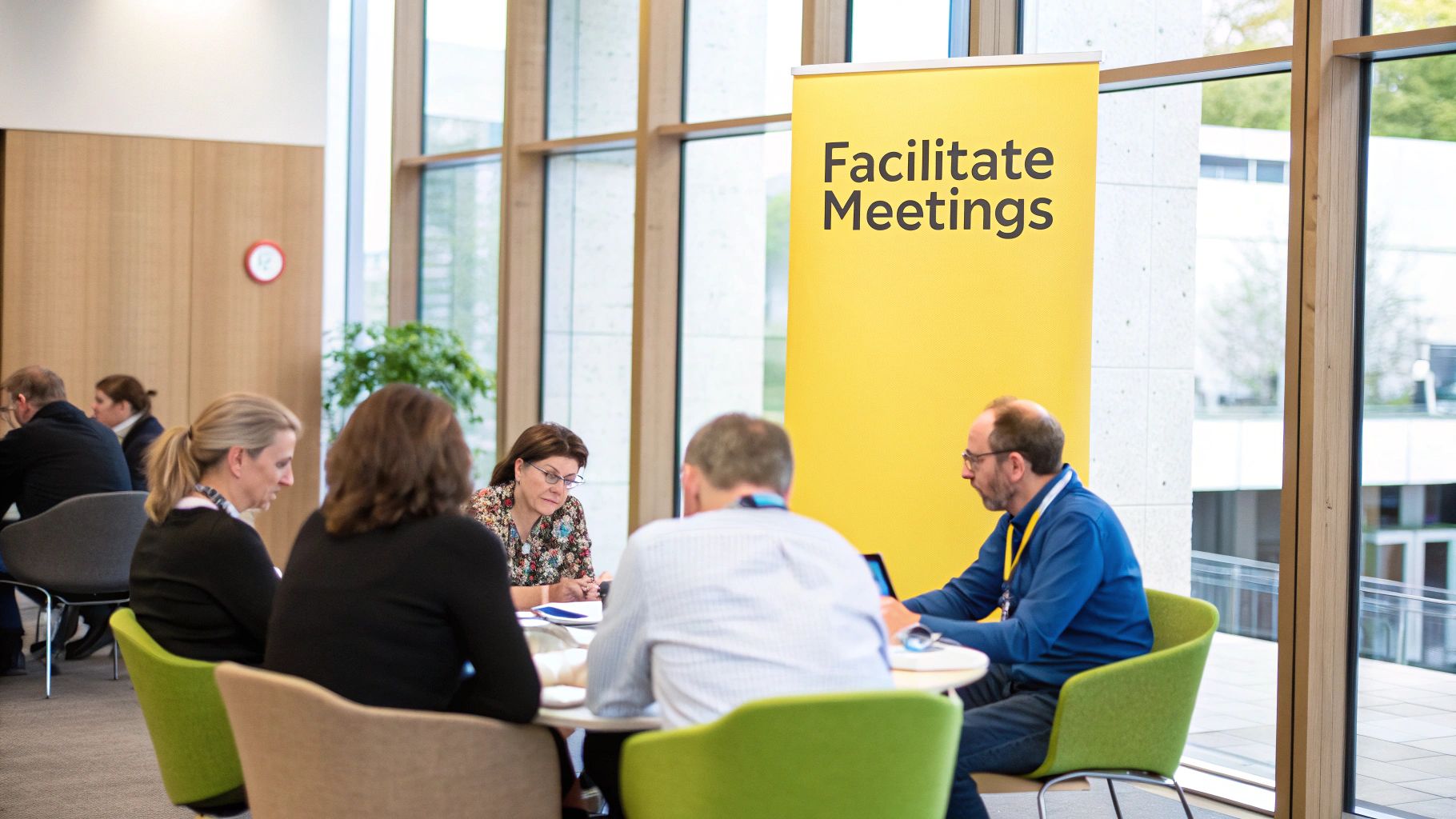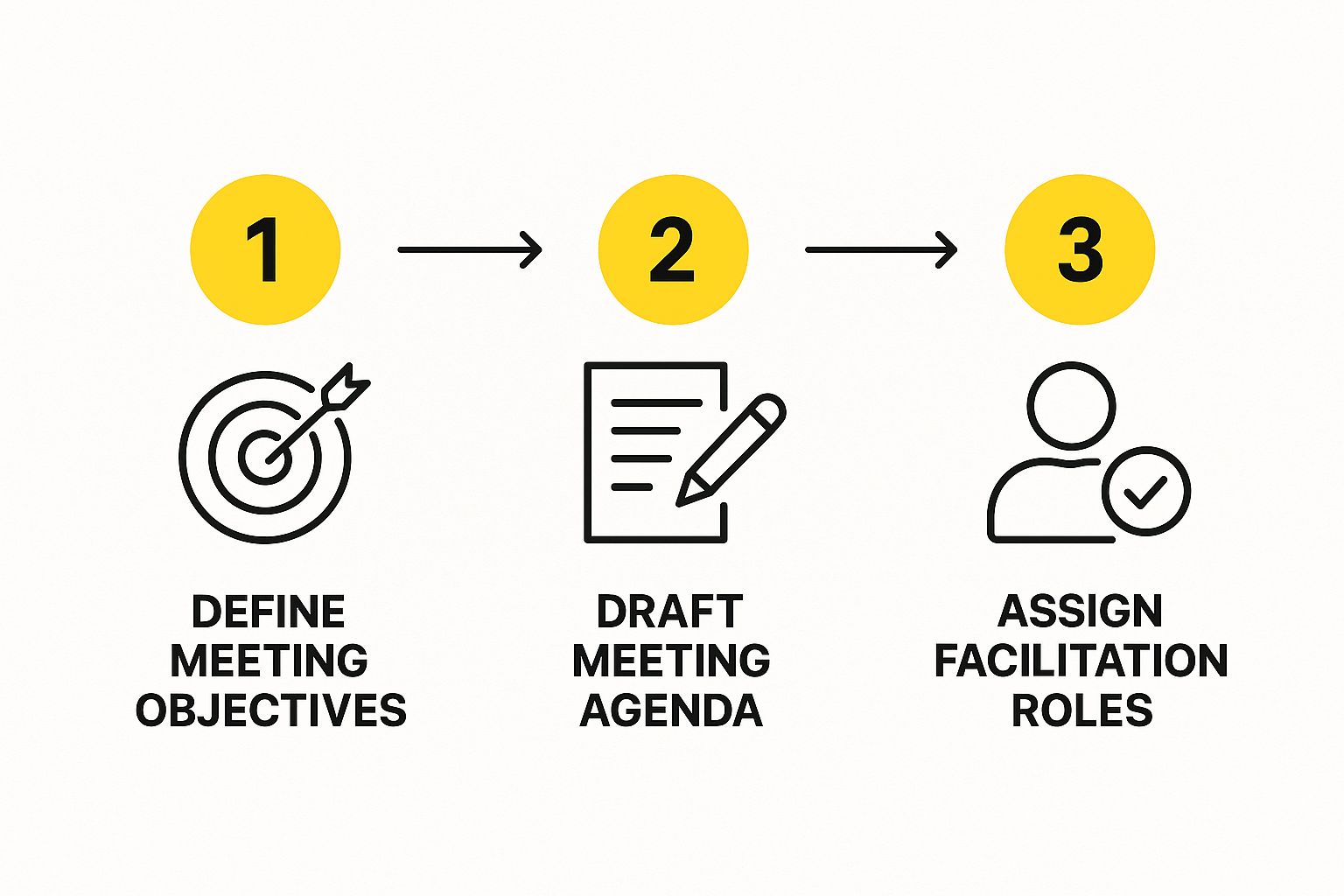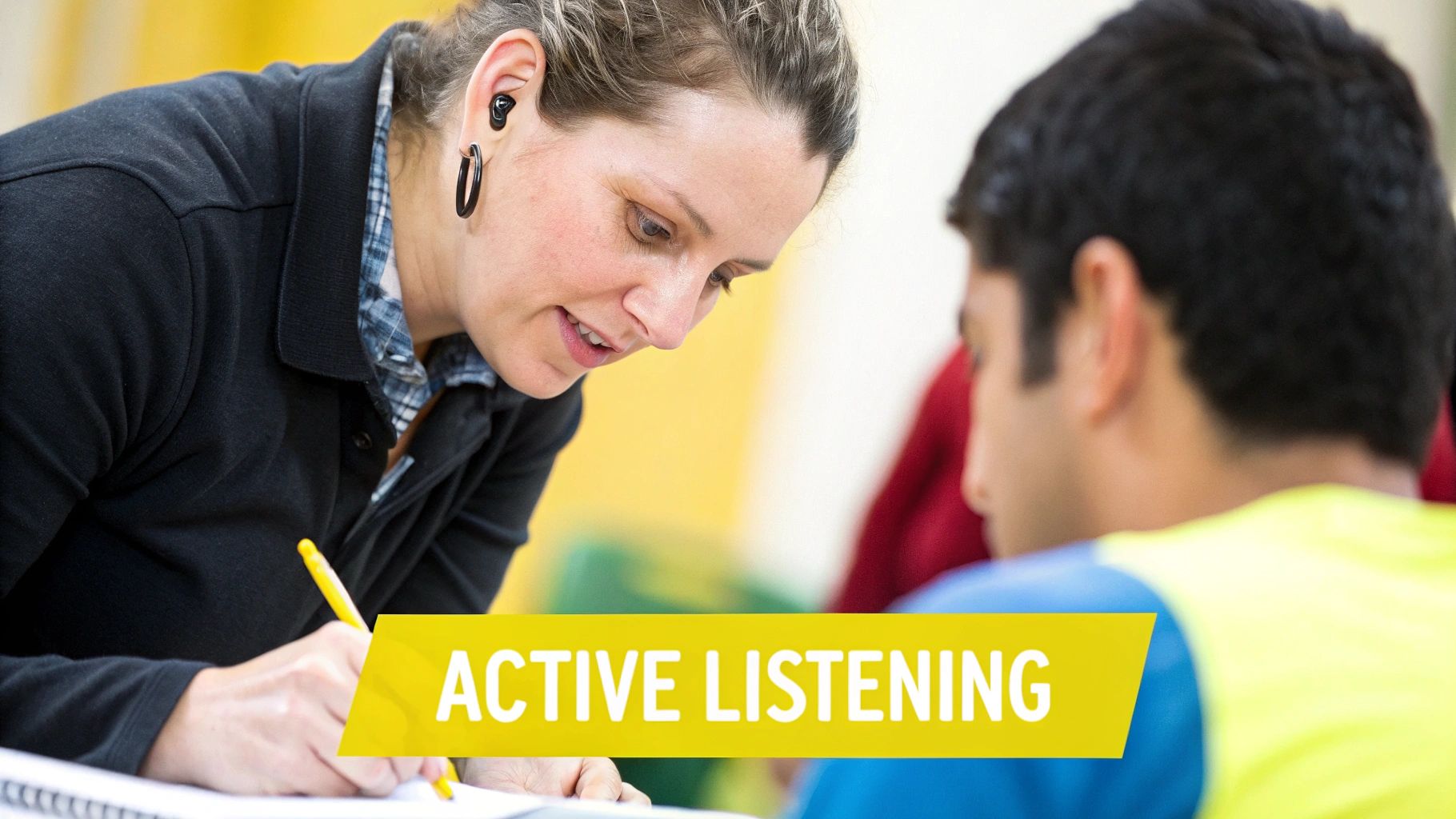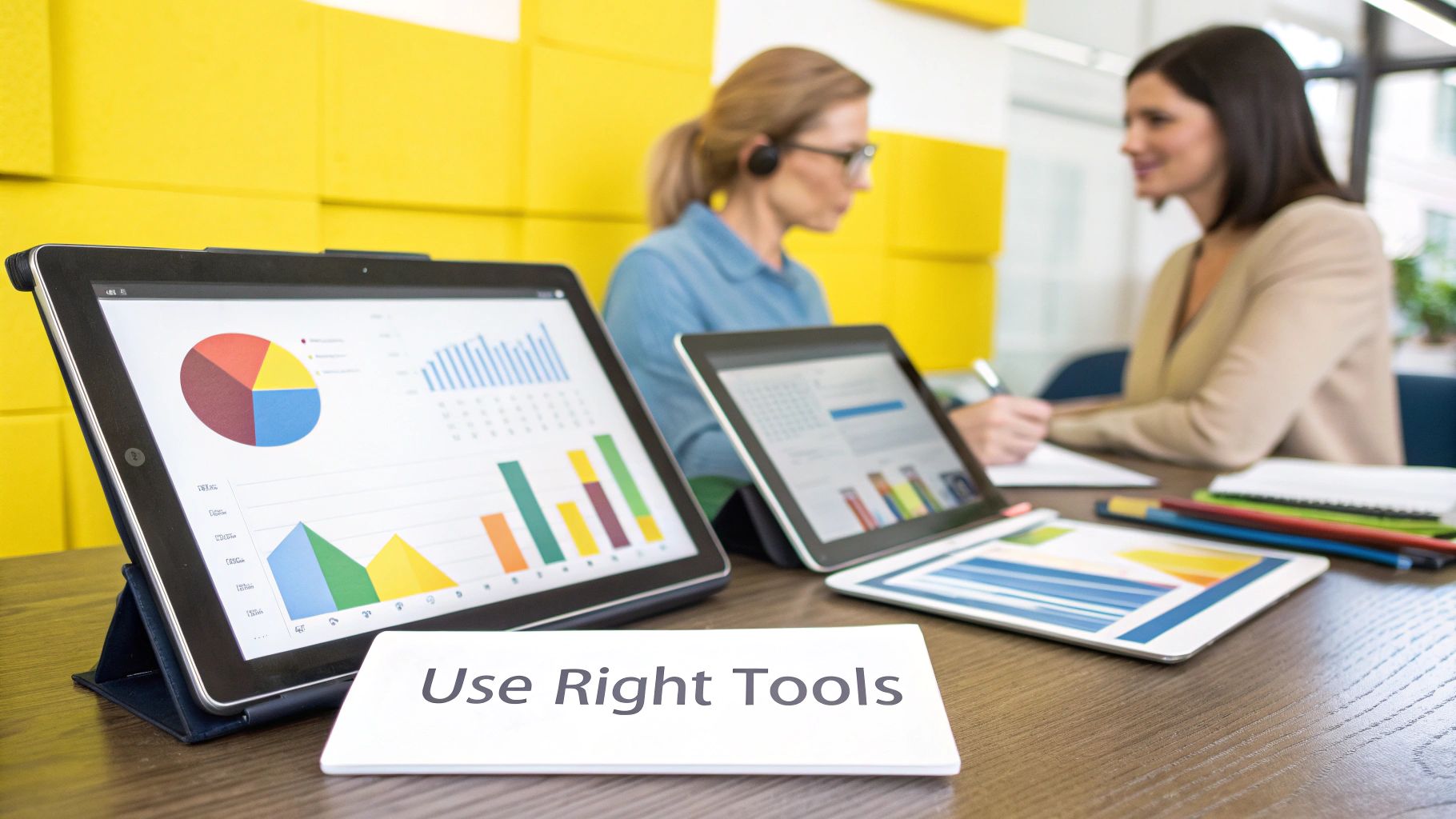We’ve all been there—the meeting that drains your energy, spirals completely off-topic, and delivers absolutely nothing. It’s a universal pain point. But what if you could turn that common frustration into a genuine competitive advantage?
That’s where meeting facilitation training comes in. It’s not just another line item in the training budget; it’s a strategic investment that equips leaders with the skills to guide discussions, lock in clear outcomes, and make every single minute count.
The High Cost of Unproductive Meetings
It’s easy to complain about bad meetings, but the real business impact goes far beyond simple frustration. When meetings are poorly run, the costs ripple through the entire organization, hitting everything from morale and productivity to the bottom line.
Each gathering without a clear purpose or skilled guidance isn’t just a waste of time—it’s a direct drain on your most valuable resources.

The Hidden Financial Drain
Think about a real-world scenario. A project kickoff meeting without a skilled facilitator quickly turns into a chaotic brainstorming session with no clear next steps. People leave confused, action items are ambiguous, and the project starts on incredibly shaky ground.
This initial confusion inevitably leads to rework, missed deadlines, and duplicated efforts. All of which have direct financial consequences.
When you do the math and calculate the blended hourly rate of every attendee, the cost of a single one-hour unproductive meeting can easily run into thousands of dollars, even for a mid-sized team. Multiply that by the number of sloppy meetings happening each week, and the numbers become staggering. It’s a huge, often overlooked, operational inefficiency. If you’re looking to tighten things up, it’s worth exploring the different ways you can reduce meeting time and improve efficiency.
Morale and Disengagement
Beyond the balance sheet, there’s a human cost. Consistently unproductive meetings breed cynicism and disengagement like nothing else.
When your team members feel their time is being disrespected or their contributions are simply ignored, their motivation plummets. This creates a vicious cycle where employees show up physically but are mentally checked out, which stifles the very innovation and collaboration you need to succeed.
A facilitator’s primary role is to create an environment of psychological safety where every voice is heard and valued. This is where meeting facilitation training moves from a “soft skill” to a core leadership competency.
Investing in skilled facilitators can dramatically reverse this trend. The right training teaches managers specific techniques for guiding groups toward inclusive and productive outcomes. It’s not just about running meetings better; it’s about fostering an environment where people feel seen, heard, and valued.
Ultimately, viewing meeting facilitation training as a crucial investment is the first step. It provides the structured approach and practical skills needed to turn those dreaded meetings into the powerful, strategic assets they were always meant to be. This isn’t just about better meetings; it’s about building a more effective and motivated organization from the ground up.
Alright, let’s get down to business. Shifting from just complaining about bad meetings to actually doing something about them takes a real plan. A top-notch facilitation training program isn’t just wishful thinking—it’s built on a solid framework that marries clear goals with hands-on practice. This is where you lay the groundwork to turn abstract facilitation theory into a concrete skill your team can use every day.
The first move is to nail down exactly what you want your trainees to walk away with. Are you trying to slash meeting times? Or maybe you’re focused on boosting the quality of decisions made? Perhaps your biggest win would be getting your quieter team members to speak up more. Your specific goals will dictate everything that follows, from the content you cover to the practice activities you design.
Defining Your Learning Objectives
Before you even think about building training modules, you have to get laser-focused on the why. Fuzzy goals like “have better meetings” just won’t cut it. You need specific, measurable outcomes that you can actually track.
For instance, a strong learning objective might sound like this: “Participants will be able to create and share a timed agenda using NASA before every meeting, cutting off-topic discussions by 50%.” See how concrete that is? It’s clear what the action is and how you’ll measure success. Here’s another one: “Trainees will use at least two techniques for engaging remote participants to ensure everyone gets a chance to contribute.”
This process is really the bedrock of any good meeting, and your training needs to reflect that. This flow is what effective facilitators live by.

This simple cycle—defining objectives, building an agenda, and assigning roles—is a fundamental discipline. Your training has to hammer this home until it becomes second nature for every participant.
Designing Your Core Training Modules
Once your objectives are locked in, you can start designing the actual training modules. Think of them as the building blocks of your program. Each module should zero in on a specific facilitation skill and, most importantly, include a practical activity where people can immediately apply what they’ve just learned.
This is where a tool like NASA really shines. You can build your entire training session as a timed agenda within the app. It’s a bit meta, but it works wonders. You’re not just keeping the training on schedule; you’re actively modeling the exact behavior you want your new facilitators to adopt.
A facilitator’s job isn’t to be the smartest person in the room on the topic at hand. Their expertise is in the process of collaboration. Your training must empower them to guide the conversation, not control it.
Here are a few essential modules I’d recommend for any meeting facilitation training curriculum:
- Agenda Architecture: This is where you teach people how to build a purpose-driven agenda. Use NASA to create a template with timed slots, crystal-clear topics, and the desired outcome for each item.
- Managing Group Dynamics: This module tackles the tricky stuff. I love running a role-playing scenario where one person is assigned the “Dominator” role and another is the “Quiet Contributor.” The trainee’s job is to use specific facilitation techniques to balance the conversation and draw everyone in.
- Driving to Decisions: Here, the focus is on synthesizing information and getting to a documented decision. Give the group a real (but low-stakes) business problem and a firm deadline. The trainee has to guide them to a clear decision with documented action items before time runs out.
Breaking down the training into these targeted modules makes complex skills feel much more manageable. It gives your trainees clear, actionable takeaways they can start using the very next day.
To give you a clearer picture, here’s a table outlining how you could structure these core modules.
Core Facilitation Training Modules
| Training Module | Learning Objective | Key Practice Activity |
|---|---|---|
| Agenda Architecture | Learn to craft agendas that are outcome-focused and realistically timed. | Build a complete meeting agenda in NASA for a sample project kickoff, including timed items and goals. |
| Managing Group Dynamics | Develop techniques to engage all participants and manage disruptive behaviors. | Role-play a meeting with “Dominator,” “Derailer,” and “Silent” participant personas. |
| Driving to Decisions | Master methods for guiding a group from discussion to a clear, documented decision. | Facilitate a 20-minute session to solve a low-stakes problem, ending with documented action items. |
| Mastering Remote Facilitation | Adapt facilitation skills for virtual environments to ensure engagement. | Lead a short, interactive virtual activity using digital whiteboards or polling tools. |
By building out your training with practical, objective-driven modules like these, you’re not just teaching theory—you’re building competent, confident facilitators who can make an immediate impact.
Core Facilitation Techniques for Modern Leaders
Great meeting facilitation training goes way beyond just managing an agenda. It’s about digging into the skills that help leaders actually guide conversations, pull together different perspectives, and lead a group to a solid decision—all without taking over the room. These are the techniques that turn chaotic meetings into sessions that actually get things done.

Honestly, true facilitation is a balancing act. It’s knowing when to jump in and when to hang back, creating a space where everyone feels safe enough to contribute but also responsible for doing so. This is especially true in hybrid meetings, where keeping remote folks engaged is a constant battle.
Cultivating Psychological Safety
If there’s one skill a facilitator has to master, it’s creating psychological safety. Without it, you’ll never get the honest feedback or creative sparks that lead to real breakthroughs. It means shutting down negative behaviors like shooting down ideas and actively encouraging people to build on each other’s thoughts.
An easy way to start is by setting clear ground rules at the beginning of every meeting. Better yet, create them with the team so everyone feels a sense of ownership. Frame it as a team effort: “What agreements can we make to ensure this is a productive and respectful chat for everyone?”
For example, your ground rules might include:
- Assume positive intent: We start from a place of trust, believing everyone is here to find the best solution.
- Challenge ideas, not people: It’s fine to poke holes in a concept, but personal attacks are out of bounds.
- One conversation at a time: We all focus on the person speaking instead of having side chats.
Active Listening and Synthesizing
A top-notch facilitator doesn’t just listen to reply; they listen to understand and connect the dots. This isn’t just about hearing the words. It’s about spotting the themes, clarifying what’s fuzzy, and summing up key points to make sure you’re all on the same page.
When someone makes a great point, repeat it back in your own words. “So, if I’m hearing you right, you’re saying we should focus on Task A because of the customer deadline. Is that right?” That simple move makes the speaker feel heard and cements the idea for the whole group.
The facilitator’s role is to act as a mirror for the group, reflecting back the collective thoughts and guiding them toward a clear image. You are the guide on the side, not the sage on the stage.
Guiding Toward Consensus
At the end of the day, a meeting needs an outcome. The facilitator’s job is to nudge the team from a freewheeling discussion to a concrete decision. This doesn’t mean forcing everyone to agree, but rather helping the group work through their differences to find a way forward.
One powerful tactic is to frame decisions as experiments. Instead of pushing for a perfect, permanent fix, try asking: “What’s one small step we can all agree to try, and then we’ll check back in?” This lowers the stakes and makes it much easier to get buy-in. This approach works wonders in agile settings, and you can learn more about mastering the retrospective sprint with best practices and tips in our other guide.
The whole game of facilitation is changing. Today’s approaches have to account for things like shorter attention spans and hybrid work. For instance, some research shows that slashing a four-hour workshop down to a focused 90-minute session can boost engagement by 30%. It’s a clear sign that facilitation has to be dynamic to fit how we work now. You can check out more insights from the full report on the state of facilitation.
Alright, you’ve got your framework ready to go. Now it’s time for the main event: running a live training session that actually shows the skills you’re teaching, not just tells. This is where all that planning pays off, turning your agenda into a learning experience people will remember.
Those first five minutes are everything. They set the tone for the entire session. So, bring the energy right from the start with a clear, powerful statement of purpose.
Forget the dry agenda rundown. Kick things off with a great question or a quick, relatable story about a meeting that went completely off the rails. This gets your audience hooked immediately and shows them exactly why this meeting facilitation training is so important for them.
Make sure you clearly state the goal for the session and what everyone will be able to do by the end. This isn’t just about listing topics; it’s about building a shared sense of mission right from the get-go.
Keeping the Session Dynamic and On Track
I’ve seen too many new trainers make this mistake: they stick to their script so rigidly that they suck all the energy out of the room. Your job is to be a guide, not a lecturer. The real magic is in balancing that structure with enough flexibility to keep the momentum going and get people involved.
To make sure your training is dynamic, mix in a variety of interactive workshop activities. It doesn’t have to be complicated. A quick poll, a two-minute breakout chat, or asking people to drop their thoughts into a shared tool can instantly re-engage the room. This is a lot like the fast feedback loops in agile development, a concept you can dig into with these essential sprint planning tips for agile teams.
Running your training right inside NASA (Not Another Standup App) is a fantastic way to practice what you preach. The timed agenda forces you to be honest with your pacing, and the built-in features give you plenty of natural spots for interaction.
Managing Disruptions and Drawing Out Input
Even the most buttoned-up plan will hit a few bumps. You’ll get off-topic tangents, and you’ll have participants who either dominate the conversation or don’t say a word. Handling these moments with grace is a core facilitation skill.
The best facilitators don’t just follow an agenda; they actively manage the energy in the room. This means knowing when to gently redirect, when to encourage debate, and when to create space for quieter voices.
Here are a few moves I use all the time:
- For the talkative participant: Acknowledge their point, then pivot. Try something like, “That’s a great point, Alex. To make sure we hear from everyone, I’d love to get someone else’s perspective on this.”
- To redirect a tangent: Use the agenda as your friendly guide. “That’s an interesting topic, maybe for another time. Let’s ‘park’ that idea for now and get back to our current agenda item, which is…”
- To engage quiet attendees: Ask open-ended questions aimed at the whole group, not one person. This takes the pressure off. For example, “What’s one thing that’s resonating with people so far?”
Your confidence in handling these situations will build with every session you lead. By running a smooth, interactive, and respectful training, you’re not just teaching facilitation—you’re showing everyone what it looks like in action.
Measuring the Impact of Your Training
A training program is only as good as its lasting impact. Once your session wraps up, the real work begins—proving that the investment in meeting facilitation training actually delivers tangible results. It’s about moving beyond feel-good feedback to track how these new skills are genuinely changing the way your teams operate day-to-day.

The goal here is to connect the dots between the training you delivered and real business outcomes. You need to find evidence that the time and resources spent are paying off in the form of increased efficiency, smarter decisions, and a healthier team culture. This isn’t just about justifying a budget; it’s about creating a cycle of continuous improvement that makes the whole organization stronger.
Tracking Real-World Effects
To measure the ROI of your training, you have to look at specific, quantifiable metrics. Abstract feedback is nice, but hard data is what proves value. Fortunately, a tool like NASA gives you a goldmine of information you can use to see what’s working.
I always recommend starting by monitoring these key performance indicators:
- Meeting Duration: Are meetings getting shorter and more focused? Track the average meeting length for teams before and after the training.
- Decision-Making Velocity: How quickly are teams moving from discussion to decision? You can use the action items and follow-ups logged in NASA to see if the time-to-decision is shrinking.
- Team Satisfaction: Tools with sentiment indicators can provide a quick pulse check on team morale and engagement levels over time, which is a great leading indicator.
This idea of using facilitation to improve project outcomes isn’t new. Project management has long recognized its value. For instance, some historical evaluations have shown that well-facilitated meetings were crucial for gathering broad input and improving outcomes in complex development projects, often using qualitative ratings to assess success.
Creating a Feedback Loop for Improvement
Measurement isn’t a one-time event. It’s an ongoing process that should fuel your next steps. This is where post-meeting follow-ups become your best friend. They serve two critical functions: reinforcing what was learned and gathering data for your next training iteration.
After a meeting, use the summary generated by your tool to send a crystal-clear recap. This is your chance to document what was decided and, crucially, who is responsible for what. For a complete look at what this should include, check out our guide on how to start perfecting meeting notes and action items for success.
The most effective training programs don’t just teach skills; they build systems for accountability. By consistently tracking outcomes and following up, you create a culture where effective meetings are the standard, not the exception.
This feedback loop is what makes the training stick. When team members see that their new facilitation efforts are being tracked and valued, they are far more likely to keep applying them. It transforms the training from a one-off session into a living, breathing part of your company’s operating system. By proving the impact, you’re not just validating your work—you’re building a stronger, more effective organization from the inside out.
Even with the best plan, you’re bound to have questions when you’re trying something new. And diving into meeting facilitation training is no different. Let’s walk through some of the common things people ask, so you can move forward with confidence.
Getting these questions answered usually provides the clarity teams need to really commit to building this skill across the board.
How Long Does It Take to Become a Good Facilitator?
Becoming a great facilitator is more of a journey than a destination. You don’t just show up one day and have it all figured out. While a formal meeting facilitation training program can get you up to speed on the core techniques in just a few days, real confidence only comes with practice.
You’ll definitely see some immediate wins in your meetings just by applying the basics. But from my experience, most leaders start feeling truly comfortable handling tricky group dynamics and complex scenarios after about three to six months of consistent, real-world application and getting feedback.
The biggest mistake I see new facilitators make is struggling to find the balance between guiding the conversation and controlling it. Your job is to provide just enough structure to keep things on track, but you have to empower the team to drive the outcomes. Think of yourself as a guide, not a lecturer.
Is This Training Only for Managers?
Absolutely not. It’s a huge misconception that facilitation is only for people with “manager” in their title. It’s a universal skill that makes anyone—regardless of their official role—a much better collaborator and problem-solver.
Team members who have strong facilitation skills are invaluable. They’re the ones who can step in to keep discussions productive, make sure everyone’s voice is heard, and nudge their peers toward a consensus, even when they aren’t the official meeting owner. This kind of training just makes you a more valuable part of any team.
And for anyone leading a discussion, one of the most crucial skills is knowing when and how to wrap things up. You can explore more strategies for how to end a meeting effectively to make sure decisions and action items are crystal clear for everyone.
This kind of shared ownership creates a much more resilient and self-sufficient team culture. When everyone feels responsible for productive collaboration, the whole organization gets a boost from faster problem-solving and better decisions. It’s really a foundational skill for modern teamwork.
Ready to transform your meetings from chaotic time-wasters into powerful strategic assets? See how resolution’s NASA – Not Another Standup App can provide the structure and tools you need. Start your journey with NASA today.
